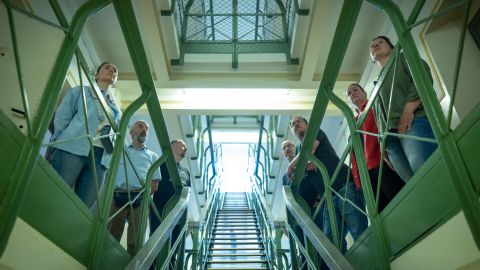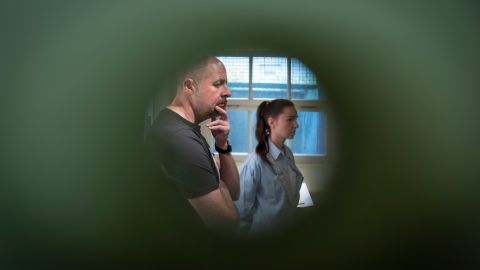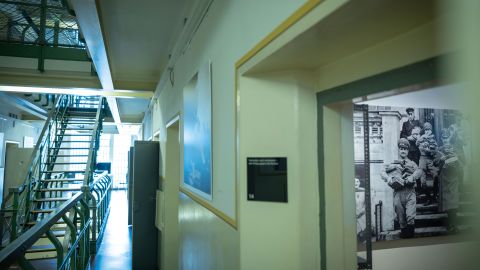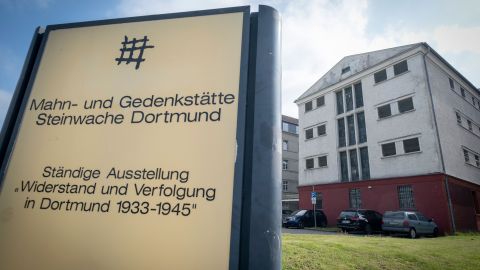Cell 4, a dungeon about ten square meters in size. A wooden cot at the back left. A heavy iron ring hangs in the wall above. Prisoners were tied to it. A "cat o' nine tails" lies in a display case. The Secret State Police (Gestapo) used the wire whip to beat confessions out of prisoners. Here, in the reception and interrogation room of the Steinwache, known as the "hell of West Germany". Police officers became enforcers of injustice, martyred social democrats who led the workers' movement in the north of Dortmund, tortured and killed Jewish citizens, Sinti and Roma, foreigners and forced laborers. The laws of democracy were suspended. Arbitrariness ruled over human rights.
In particular in connection with right-wing extremist content in chats of service groups of the Essen-Mülheim PP, the question of dealing with the organizational past came into focus. Today, the "promotion of democratic resilience" is a focus of studies and further training.
On a table in Dortmund's basement dungeon lies a yellowed prison book from June 1933, when the last democratic party was crushed and the German Reich finally turned into a totalitarian system. The open page documents personalities from the workers' movement, including the name of Dortmund's mayor at the time, Fritz Henßler. Arrest: 4.25 pm. Reason for arrest: no details. Valuables: none. The Social Democrat was held in protective custody for ten weeks without a court order. The prosecution pleaded treason, but had no evidence. Henßler was therefore later interned in the Sachsenhausen concentration camp in Brandenburg until the end of the war in 1945.
How did it come about that the entire police apparatus became the recipient of orders from a dictator and only a few officers tried to keep their conscience? "It's unbelievable that people no longer had any rights and that there was no more humanity," says police superintendent Josephine Krautkrämer, who is standing thoughtfully with her colleagues in a cell on the third floor. Clear marks can be seen under the peephole of the heavy iron door. Desperate prisoners banged violently against the metal because police officers had crammed them in here during the nights of bombing in 1945.
Dortmund was reduced to rubble and ashes. Miraculously, the stone guardhouse remained standing: five storeys, cells for 126 prisoners. Today, there is a training room to the right of the entrance. This is where the police officers will later discuss group dynamics and touch on topics such as propaganda and perpetrator logic. Historian Jan Pohl will ask: "What happens when a prisoner is no longer seen as a human being, but as a parasite, a pest?"
Giving food for thought, making people think. Interior Minister Herbert Reul spoke of a "vitamin cure for democratic defenses" when he presented the 80-page final report "Right-wing extremist tendencies in the North Rhine-Westphalia police force" in September 2021. Prior to this, xenophobic and inhumane content had become public, circulating in police chat groups. The report made 18 recommendations for action to promote democratic values among the more than 50,000 police employees in NRW.
The memorial project is about remembering the mistakes of the past in order to draw conclusions for the present.
Hendrik Mathias, Officer at the State Office for Training, Further Education and Personnel Affairs of the NRW Police (LAFP NRW)
In the past, service groups have also visited memorials - but usually only those in the immediate vicinity. "Now, for example, police officers from Münster can also book workshops at the former Nazi Ordensburg Vogelsang in the Eifel region, where the elite for the NSDAP leadership cadre was trained between 1936 and 1939," explains Mathias.
The colleagues from the Huckarde police station are standing in front of ceiling-high photos of barbed wire fences with dead people hanging in them. "Arbeit macht frei" is written above the gate of a concentration camp. Once again, an awkward silence. The tour is over, now group work is on the agenda.
"Did you know that Dortmund police officers shot people in the Warsaw ghetto?" asks Chief Superintendent Moritz Altenheiner. His colleagues shake their heads. In an essay, they learn more about the murder battalion that took food rations, money and jewelry from Jews. Men, women and children were flogged or shot without warning - just like that. There was no order. "It's terrible, it gives me goose bumps," says police chief inspector Thomas Kaiser.
Back to the training room. There, the results of the group work are compiled on a flipchart. More questions arise: Why did so many take part? Why did hardly anyone question the orders? Everyone agrees: "Such atrocities would no longer be possible in Germany."
At the end, the group takes one last look at the iron staircase of the stone guardhouse, which leads from the cellar to the roof. The wire mesh that the Gestapo installed in 1934 is still hanging on the first floor. The reason: they wanted to prevent prisoners from throwing themselves to their deaths after agonizing torture interrogations instead of continuing to live.
The ten memorial sites
Memorial and memorial site | Düsseldorf
Opened in the historic town hall in the old town. The building was the seat of the police headquarters until 1934.
NS Documentation Center | Cologne
From 1935 to 1945, the EL-DE building on Appellhofplatz was the headquarters of the Cologne Gestapo.
Vogelsang Castle | Schleiden
Former National Socialist Ordensburg Vogelsang
Old Synagogue | Wuppertal
The memorial is located on the site where the Elberfeld synagogue stood until November 1938.
Villa ten Hompel | Münster
The villa was the headquarters of the police under National Socialism.
Wewelsburg | Büren
The Wewelsburg memorial site explores the activities of the Schutzstaffel (SS)
Steinwache | Dortmund
The Steinwache in Dortmund used to be a police prison.
Old Synagogue | Essen
The city's cultural institute is located in the former synagogue building of the Jewish community.
Jewish Museum of Westphalia | Dorsten
The permanent exhibition "L'Chaim - To Life" at the Jewish Museum Westfalen in Dorsten, which opened in 2018, offers insights into Jewish culture and religion.
Villa Merländer | Krefeld
Villa Merländer has been the official Nazi documentation center of the city of Krefeld since 1991.



